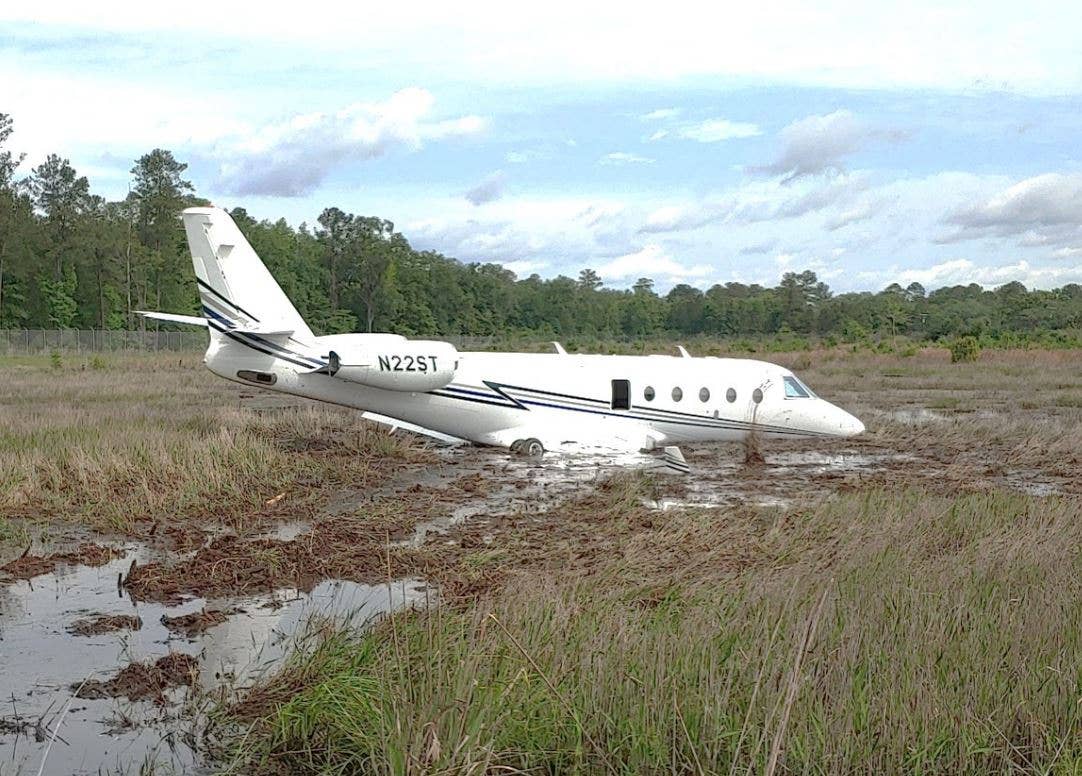NTSB: Rushed Flight Contributed to Gulfstream G150 Runway Overrun
The cockpit recording indicates the pilots were racing to land ahead of another jet, according to the National Transportation Safety Board report.

View of the G150 at the accident site. [Credit: NTSB]
The National Transportation Safety Board (NTSB) released its final report on a runway overrun accident on May 5, 2021, at Ridgeland-Claude Dean Airport (3J1) in South Carolina. The accident resulted in substantial damage to the aircraft, a Gulfstream G150 registered to Israel Aerospace Industries Ltd. The two crewmembers and three passengers on board were not injured, the NTSB said.
During a flight from New Smyrna Beach Municipal Airport (KEVB) in Florida to Ridgeland, the aircraft’s cockpit voice recorder (CVR) recorded information indicating that the pilot in command (PIC) wanted to complete the flight as quickly as possible and arrive at the destination airport ahead of another aircraft.
According to the NTSB report, a passenger asked the crewmembers about the estimated time of arrival, and the PIC replied, “I’ll speed up. I’ll go real fast here.” A minute or so later, the second in command (SIC) noted the airplane’s airspeed was 300 knots and its altitude was 9,000 feet. For the next few minutes, the crew talked about ways to shorten the flight time, the report said. The pilots also noted that another jet on the radio was headed to 3J1.
The PIC said the other aircraft’s estimated arrival time was 10:33, local time or about two minutes ahead of the eventual accident aircraft. The CVR recorded the PIC commenting that the other jet would “slow to 250 [knots] below 10 [thousand feet] and we won’t. We know what we’re doing right now. We’re trying to win a race.” The SIC can be heard replying, “That’s right,” and the PIC said, “This is NASCAR,” after which laughter can be heard on the recording.
At Ridgeland, the crew performed a straight-in visual approach to land on Runway 36. The airplane was high and fast throughout the final approach “as evidenced by the SIC’s airspeed callouts,” per the NTSB report. The SIC asked if S-turns were necessary, and the PIC replied that they were not.
The CVR recorded an electronic voice giving repeated “sink rate” and “pull-up” warnings during the final approach, indicating the approach was not stable. The pilots continued the landing, touching down about 1,000 feet down the 4,200-foot runway. The airplane failed to stop in time, overran the runway, and came to rest in a marshy area about 400 feet beyond the departure end. The fuselage and wings sustained substantial damage, according to the NTSB.
The PIC later said the airplane’s wheel brakes, thrust reversers, and ground air brakes did not function after touchdown, but evidence from witnesses and video indicated the thrust reversers deployed shortly after touchdown. Tire skid marks indicated that wheel braking “occurred throughout the ground roll,” the report said. NTSA said the ground air brakes did not deploy, and tests performed to determine why were inconclusive.
The NTSB said the probable cause of the accident was “the flight crew’s continuation of an unstable approach and the failure of the ground air brakes to deploy upon touchdown, both of which resulted in the runway overrun. Contributing was the crew’s motivation and response to external pressures to complete the flight as quickly as possible to accommodate passenger wishes and the crew’s decision to land with a quartering tailwind that exceeded the airplane’s limitations.”

Sign-up for newsletters & special offers!
Get the latest FLYING stories & special offers delivered directly to your inbox






